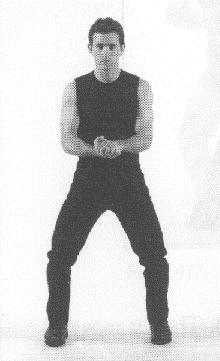
Fig. 424
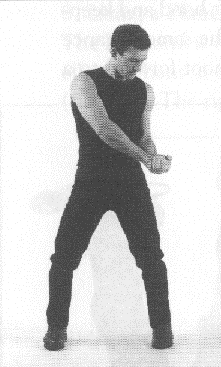
Fig. 425
11. Clasping Hands
Both forearms are brought forward in front of the navel. The bent elbows almost touch the rib cage. The hands are made to clasp, the left hand on top. The fingers of each hand grab the other hand forcefully (fig. 424). All the muscles of the arms and the back are contracted. Then the tense muscles are relaxed and the hands change positions so that the right hand is on top of the left, without letting go of each other, using the hard part of the palm at the base of the fingers as a pivoting surface; the muscles of the arms and back are contracted again.
The same movements are repeated, beginning with the right hand on top.
12. Left and Right Body Clasp
The forearms are brought in front of the body, again at the level of the navel. This time, however, the right forearm is held extended out in a straight line with the hip. It is held close to the rib cage while the left forearm, with the elbow away from the body, puts the left hand over the right one in a clasping position. Great pressure is applied to the palms and the fingers of each hand by the tension of the muscles of the arms, the back, and the abdomen. The tension is relaxed, and the hands are made to pivot on each other's palms, as they move across the body from right to left. There, they are forcefully clasped again, using the same muscles, this time with the right hand on top (fig. 425).
The same movements are repeated from this position.

Fig. 424 |

Fig. 425 |
13. The Sharp Turn of the Two Bodies
The hands are clasped at the level of the waist, to the right. The left hand is on top of the right. In this magical pass, the squeeze of the hands is not as pronounced as the one in the two preceding ones, because what is sought is a sharp rum of the two bodies, rather than the sharp strikes of the two preceding passes.
The clasped hands are made to draw a small circle to the right that goes from the front to the back, and ends in the same position where it started. Since the leading hand is the left hand, by the fact that it is on top, the circle is drawn following the impulse of the left arm, which pushes the hands out first to the right, and around in a circle to the right of the body (fig. 426).
Then the clasped hands move across the front of the body to the left side. Another circle is drawn Figure 426 there, again following the impulse of the left hand.
Being on top, it pulls the other hand to make a circle that goes to the back first, out to the left, and back to the place where it started (fig. 427).
The same sequence of movements is performed with the right hand in the
lead, starting at the left by the waist. This time, the impulse of the
right arm is followed in order to draw the circle, which goes to the left
first, and then back to the same place where it started (fig. 428). The
clasped hands move across the front of the body to the right side by the
waist. There, following the impulse of the leading hand, they are pulled
back, then to the right, and back where they started, making a circle (fig.
429). It is important that as the circles are drawn, the trunk of the body
is turned sharply to the side. The legs remain in the same position, without
compensating for the turn by letting the knees sag.
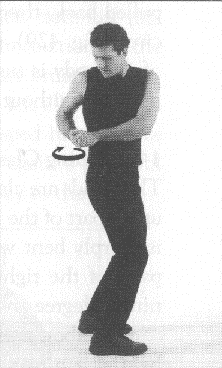
Fig. 426 |
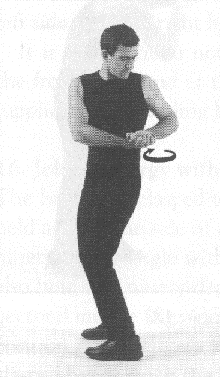
Fig. 427 |
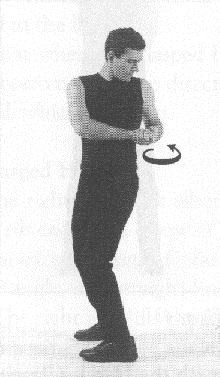
Fig. 428 |
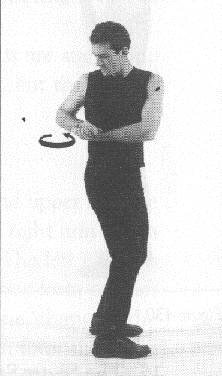
Fig. 429 |
14. Pushing Clasped Energy with the Elbow and Forearm
The hands are clasped by the right side at the level of the shoulder. The upper part of the right arm is held tight against the chest, and the elbow is sharply bent with the forearm held in a vertical position. With the palm of the right hand facing up, the back of the hand is held in a ninety-degree angle with the forearm (fig. 430).
The elbow of the left arm is extended in front of the left shoulder, held at a ninety-degree position. The two hands clasp forcefully (fig. 431). The right arm slowly pushes the left one forward by straightening the elbow quite a bit. At the same time that the clasped hands are pushed forward, the left shoulder and shoulder blade are also pushed forward to maintain the ninety-degree angle of the left elbow (fig. 432). The right arm retrieves the left hand to the initial position.
The clasped hands are shifted to the left side by pivoting on the palms,
and the same movements are repeated there.
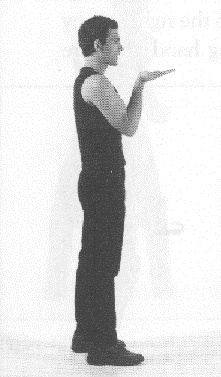
Fig. 430 |
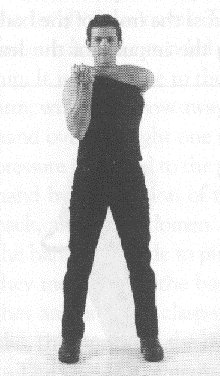
Fig. 431 |
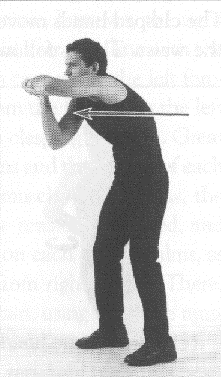
Fig. 432 |
15. The Short Stab with the Hands Clasped
The hands are clasped at the right side, just as in the preceding magical pass. This time, however, the hands are at the level of the waist, and the right arm, instead of slowly pushing the left one forward, stabs fast (fig. 433). It is a powerful movement that requires the contraction of the muscles of the arms and the back. The clasped hands are brought forcefully to the left, as if to augment the driving force of the left elbow, which is pushed all the way to the back (fig. 434). The clasped hands move around the front of the body to the right, as if to aid again a powerful movement of the right elbow which is thrown all the way to the back.
The same sequence of movements is performed by starting it on the left side with the right hand in the lead.
It is important to note that when the clasped hands are stabbed to the
front, the hand at the bottom gives the direction, but the force is supplied
by the leading hand, which is on top.
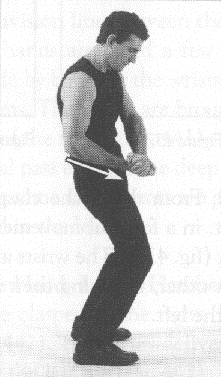
Fig. 433 |
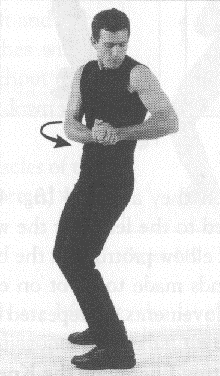
Fig. 434 |
16. Jolting Energy with Clasped Hands
The hands are clasped to the right; the right elbow and upper arm are
held against the side of the rib cage. The elbow of the right arm is at
a ninety-degree angle with the extended right forearm. The left elbow is
also held at a ninety-degree angle, at a straight line away from the left
pectoral muscle (fig. 435). The right arm lifts the left one, changing
the position of the elbows from a ninety-degree angle to a forty-five.
The clasped hands reach the level of the right shoulder (fig. 436). Then
they are made to jolt with a very short movement in which only the wrist
is involved. The clasped hands hit down, but without changing the level
at which they are held (fig. 437). From there, the clasped hands are retrieved
to the left near the waist, in a forceful movement that makes the left
elbow protrude at the back (fig. 438). The wrists are rotated and the hands
made to pivot on each other, reversing their position. The same movements
are repeated on the left.
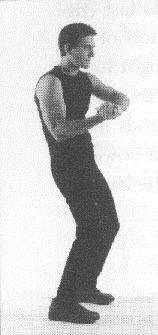
Fig. 435 |
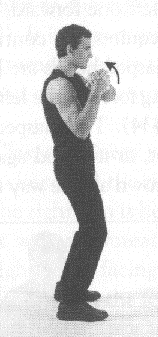
Fig. 436 |
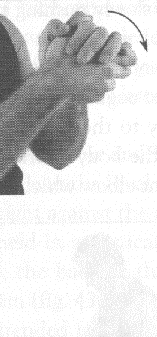
Fig. 437 |
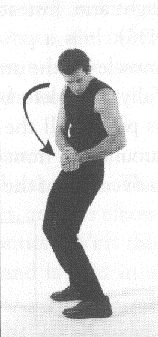
Fig. 438 |
17. Jolting Energy by the Knees
The hands are clasped to the right by the thigh. They change positions slightly by the supporting right hand, which is on the bottom, becoming slightly more vertical with a twist of the wrist, held in check by the pressure of the left hand (fig. 439). Both hands swing to the left, following the contour of the knees, and deliver a strike, the potency of which is enhanced by a downward pull of the wrists (fig. 440).
The hands change position by rotating on each other's palms, and the same movements are repeated from left to right.
18. Driving Down a Spike of Energy
The hands are clasped vertically with the left hand in the lead, at a point about a foot from the navel, right on the division line between the left and right bodies. Both hands are lifted a few inches with a slight jolt made by bending the wrists without moving the forearms. Then they are brought down with the same jolt of the wrists (fig. 441).
This magical pass engages the deep muscles of the abdomen. The same
movements are performed with the right hand in the lead.
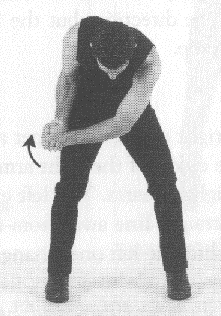
Fig. 439 |
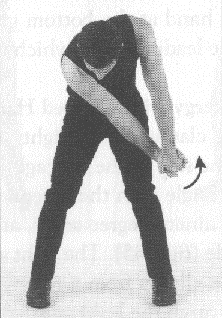
Fig. 440 |
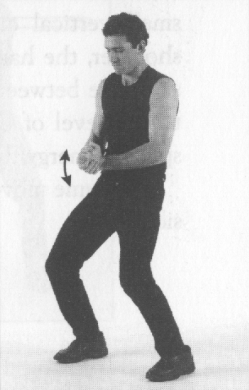
Fig. 441 |
19. Using the Hands Like a Hatchet
The hands are clasped at the right. Both are lifted to the level of the shoulder (fig. 442). Then they deliver a diagonal strike that takes them to the level of the left hip (fig. 443).
The same movements are done on the left.
20. Hammering a Spike of Energy
The hands are clasped at the right. They swing to the level of the shoulders, aided by a rotation of the trunk to the right. Making a small vertical circle in front of the right shoulder, the hands are brought to the division line between the two bodies and down to the level of the waist as if to hammer a spike of energy there (fig. 444).
The same movements are done on the left side.
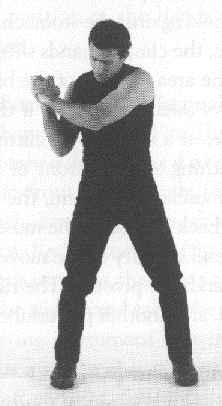
Fig. 442 |
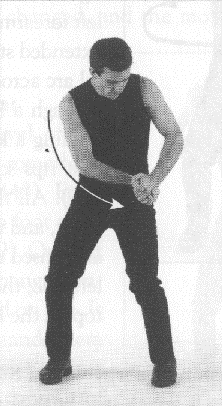
Fig. 443 |
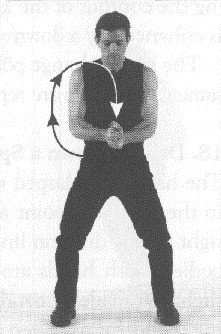
Fig. 444 |